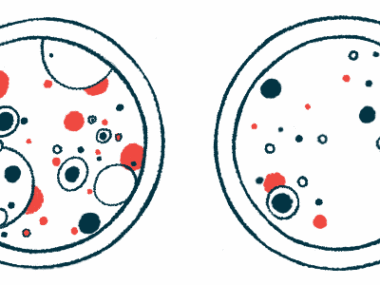Home monitoring detects flares, helps evaluate treatment in children
Nighttime cough, airway congestion could indicate poorer antibiotic response
Written by |

At-home telemonitoring of lung function in children with cystic fibrosis (CF) can detect the early onset of pulmonary exacerbations, or a sudden worsening of lung symptoms, and may help in determining the likelihood of a child’s response to treatment, a study reported.
Its researchers proposed thresholds for lung function using home spirometry that could identify children who may not respond fully to antibiotic treatment.
“Home spirometry may facilitate the early recognition of [pulmonary exacerbations] to implement earlier interventions,” the scientists wrote.
The study, “Home-spirometry exacerbation profiles in children with cystic fibrosis,” was published in the journal Pediatric Pulmonology.
Exacerbations can cause lasting lung damage in children with cystic fibrosis
CF is caused by a poorly working or produced CFTR protein, resulting in the thickening of mucus in organs like the lungs and chronic inflammation and infection.
A complication of such CF symptoms is pulmonary exacerbations or flares, a sudden increase in lung symptoms such as cough, sputum production, and shortness of breath. These events are associated with poorer lung health and are a strong predictor of disease progression among children with CF.
Because exacerbations commonly are triggered by infections, intravenous (into-the-vein, IV) antibiotics typically are given to rapidly relieve symptoms.
Telemedicine is an emerging approach to disease management that allows patients to be monitored in a home setting. Telemonitoring of lung function tests, called spirometry, which measures the speed and/or amount of air a person can breathe in and out, can provide ongoing information on lung status to clinicians.
Bordeaux University Hospital in France has been using at-home spirometry for children with CF to monitor lung function changes before, during, and after exacerbations.
Scientists at that hospital evaluated the potential of its telemonitoring program to detect early responses to IV antibiotic treatment by changes in lung health, and how such changes related to monitored exacerbations.
“It may be interesting to identify early markers of bad response to IV [antibiotics] for [exacerbations] to reappraise the management of such children with CF,” the researchers wrote.
Telemonitoring was performed with Spirobank Smart, a home spirometer that connects to a free mobile phone application.
Researchers identified 346 IV antibiotic courses for severe exacerbations that occurred in 65 patients using symptom and home spirometry from 2017 through 2021. Patients had a mean age of 10.8, and 34 were boys (52%).
Data were analyzed over four periods based around the initiation of IV antibiotics (day one): the baseline period (45 to 31 days before treatment), the period before antibiotic use started (30 to zero days), the period of IV antibiotic treatment (day one to 14), and a follow-up period after IV antibiotics (15 to 60 days). Tests of lung function after treatment were conducted in the hospital.
Nighttime cough could indicate a flare weeks before treatment might start
The prevalence of nighttime cough was the first sign of an exacerbation, and it significantly increased between baseline and 17 days before treatment.
A drop in lung health, as assessed by forced expiratory volume in one second (FEV1) spirometry — which measures the amount of air that can be forcibly exhaled in one second — significantly was evident eight days before treatment. Fatigue increased by day seven, a worsening of airway congestion by day eight, and a loss of appetite by day nine.
“These symptoms should be considered relevant to be inputted in the telemonitoring system for the early detection of [exacerbations],” the team wrote.
No changes were noted in fever and with coughing up blood.
Treatment responses then were analyzed in a subgroup of 56 patients with 276 IV antibiotic courses; data covering baseline measures and/or follow-up periods were lacking for others.
An overall increase in FEV1, indicating better lung function, was seen after treatment started. Of the 276 IV antibiotic courses, 164 (59%) had a mean FEV1 after antibiotic treatment at least equal to the mean baseline FEV1 period (45 to 31 days before treatment). Complete recovery was seen in 74% of patients between eight and 14 days after treatment.
Worse FEV1 responses (a low FEV1 after treatment versus FEV1 at baseline) were seen in patients with a delayed start of treatment after an FEV1 drop. Likewise, a faster decline in lung function before treatment correlated with a low FEV1 response after treatment.
“The later the [IV antibiotic] treatment was initiated after the FEV1 drop, the worse was the FEV 1 response,” the researchers wrote. “In the same manner, the steeper the decline in FEV1, the worse the FEV1 response.”
Two features seen to predict strong or poor responses during treatment
The persistence of airway congestion and nighttime cough during IV antibiotic use (days one to 14 of treatment) alone were seen to predict a lung function response after treatment.
“We looked for baseline predictive factors associated with a low response but could not identify relevant markers,” the researchers noted.
The optimal time to detect a likely low or poor response, meaning an FEV1 recovery of less than 94% of baseline measures, was on day 14. Among likely highest or best responders, those with an FEV1 recovery greater than 110% of baseline, the optimal time was by day nine.
This study “adds insight regarding the aggravation and recovery phases of severe [pulmonary exacerbations] in [children with CF],” the scientists concluded.
“We herein propose clinical thresholds that can easily be used to identify responses to IV [antibiotics],” they added. “Prospective studies [over time] may be based on these thresholds to evaluate the usefulness of adapting the [antibiotic] protocol or other treatments in nonresponding patients.”







